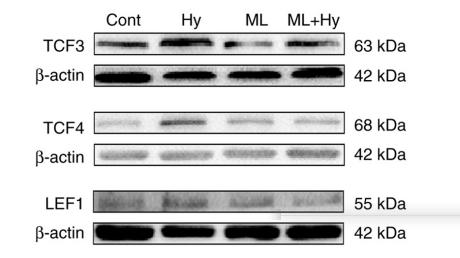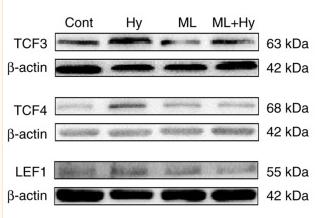| 产品: | TCF7L2 抗体 |
| 货号: | DF7622 |
| 描述: | Rabbit polyclonal antibody to TCF7L2 |
| 应用: | WB |
| 文献验证: | WB |
| 反应: | Human, Mouse, Rat, Monkey |
| 预测: | Pig, Zebrafish, Horse, Sheep, Xenopus |
| 分子量: | 68 kDa, 50 kDa; 68kD(Calculated). |
| 蛋白号: | Q9NQB0 |
| RRID: | AB_2841109 |
产品描述
*The optimal dilutions should be determined by the end user.
*Tips:
WB: 适用于变性蛋白样本的免疫印迹检测. IHC: 适用于组织样本的石蜡(IHC-p)或冰冻(IHC-f)切片样本的免疫组化/荧光检测. IF/ICC: 适用于细胞样本的荧光检测. ELISA(peptide): 适用于抗原肽的ELISA检测.
引用格式: Affinity Biosciences Cat# DF7622, RRID:AB_2841109.
展开/折叠
HMG box transcription factor 4; hTCF 4; hTCF-4; T cell factor 4; T cell specific HMG box; T cell specific transcription factor 4; T-cell factor 4; T-cell-specific transcription factor 4; TCF 4; TCF-4; TCF4; TCF7L2; TCF7L2 protein; TF7L2_HUMAN; Transcription factor 7 like 2; Transcription factor 7 like 2 T cell specific HMG box; Transcription factor 7-like 2;
抗原和靶标
Detected in epithelium from small intestine, with the highest expression at the top of the crypts and a gradient of expression from crypt to villus. Detected in colon epithelium and colon cancer, and in epithelium from mammary gland and carcinomas derived therefrom.
- Q9NQB0 TF7L2_HUMAN:
- Protein BLAST With
- NCBI/
- ExPASy/
- Uniprot
MPQLNGGGGDDLGANDELISFKDEGEQEEKSSENSSAERDLADVKSSLVNESETNQNSSSDSEAERRPPPRSESFRDKSRESLEEAAKRQDGGLFKGPPYPGYPFIMIPDLTSPYLPNGSLSPTARTLHFQSGSTHYSAYKTIEHQIAVQYLQMKWPLLDVQAGSLQSRQALKDARSPSPAHIVSNKVPVVQHPHHVHPLTPLITYSNEHFTPGNPPPHLPADVDPKTGIPRPPHPPDISPYYPLSPGTVGQIPHPLGWLVPQQGQPVYPITTGGFRHPYPTALTVNASMSRFPPHMVPPHHTLHTTGIPHPAIVTPTVKQESSQSDVGSLHSSKHQDSKKEEEKKKPHIKKPLNAFMLYMKEMRAKVVAECTLKESAAINQILGRRWHALSREEQAKYYELARKERQLHMQLYPGWSARDNYGKKKKRKRDKQPGETNEHSECFLNPCLSLPPITDLSAPKKCRARFGLDQQNNWCGPCRRKKKCVRYIQGEGSCLSPPSSDGSLLDSPPPSPNLLGSPPRDAKSQTEQTQPLSLSLKPDPLAHLSMMPPPPALLLAEATHKASALCPNGALDLPPAALQPAAPSSSIAQPSTSSLHSHSSLAGTQPQPLSLVTKSLE
种属预测
score>80的预测可信度较高,可尝试用于WB检测。*预测模型主要基于免疫原序列比对,结果仅作参考,不作为质保凭据。
High(score>80) Medium(80>score>50) Low(score<50) No confidence
研究背景
Participates in the Wnt signaling pathway and modulates MYC expression by binding to its promoter in a sequence-specific manner. Acts as repressor in the absence of CTNNB1, and as activator in its presence. Activates transcription from promoters with several copies of the Tcf motif 5'-CCTTTGATC-3' in the presence of CTNNB1. TLE1, TLE2, TLE3 and TLE4 repress transactivation mediated by TCF7L2/TCF4 and CTNNB1. Expression of dominant-negative mutants results in cell-cycle arrest in G1. Necessary for the maintenance of the epithelial stem-cell compartment of the small intestine.
In vitro, phosphorylated by TNIK.
Phosphorylated at Thr-201 and/or Thr-212 by NLK. Phosphorylation by NLK at these sites inhibits DNA-binding by TCF7L2/TCF4, thereby preventing transcriptional activation of target genes of the canonical Wnt/beta-catenin signaling pathway.
Polysumoylated. Sumoylation is enhanced by PIAS family members and desumoylation is enhanced by SENP2. Sumoylation/desumoylation regulates TCF7L2/TCF4 transcription activity in the Wnt/beta-catenin signaling pathway without altering interaction with CTNNB1 nor binding to DNA.
Nucleus>PML body.
Note: Diffuse pattern. Colocalizes with SUMO1 and PIAS4 in a subset of PML (promyelocytic leukemia) nuclear bodies.
Detected in epithelium from small intestine, with the highest expression at the top of the crypts and a gradient of expression from crypt to villus. Detected in colon epithelium and colon cancer, and in epithelium from mammary gland and carcinomas derived therefrom.
Interacts with TGFB1I1 (By similarity). Interacts with CTNNB1 (via the armadillo repeat); forms stable transcription complex. Interacts with EP300. Interacts with NLK. Interacts with CCDC85B (probably through the HMG box); prevents interaction with CTNNB1. Interacts with TNIK. Interacts with MAD2L2; prevents TCF7L2/TCF4 binding to promZIPK/DAPK3oters, negatively modulating its transcriptional activity. Interacts with ZIPK/DAPK3. Interacts with XIAP/BIRC4 and TLE3. Interacts with DDIT3/CHOP. The CTNNB1 and TCF7L2/TCF4 complex interacts with PML (isoform PML-4). Identified in a complex with CTNNB1 and FERMT2. Interacts with SPIN1. Interacts with C11orf84/SPINDOC in a SPIN1-dependent manner.
The promoter-specific activation domain interacts with the transcriptional coactivator EP300.
Belongs to the TCF/LEF family.
研究领域
· Cellular Processes > Cellular community - eukaryotes > Adherens junction. (View pathway)
· Environmental Information Processing > Signal transduction > Wnt signaling pathway. (View pathway)
· Environmental Information Processing > Signal transduction > Hippo signaling pathway. (View pathway)
· Human Diseases > Infectious diseases: Viral > Human papillomavirus infection.
· Human Diseases > Cancers: Overview > Pathways in cancer. (View pathway)
· Human Diseases > Cancers: Specific types > Colorectal cancer. (View pathway)
· Human Diseases > Cancers: Specific types > Endometrial cancer. (View pathway)
· Human Diseases > Cancers: Specific types > Prostate cancer. (View pathway)
· Human Diseases > Cancers: Specific types > Thyroid cancer. (View pathway)
· Human Diseases > Cancers: Specific types > Basal cell carcinoma. (View pathway)
· Human Diseases > Cancers: Specific types > Acute myeloid leukemia. (View pathway)
· Human Diseases > Cancers: Specific types > Breast cancer. (View pathway)
· Human Diseases > Cancers: Specific types > Hepatocellular carcinoma. (View pathway)
· Human Diseases > Cancers: Specific types > Gastric cancer. (View pathway)
· Human Diseases > Cardiovascular diseases > Arrhythmogenic right ventricular cardiomyopathy (ARVC).
· Organismal Systems > Endocrine system > Melanogenesis.
文献引用
Application: WB Species: rat Sample: atria
Application: WB Species: rat Sample: atria
Application: WB Species: Rat Sample: atria
限制条款
产品的规格、报价、验证数据请以官网为准,官网链接:www.affbiotech.com | www.affbiotech.cn(简体中文)| www.affbiotech.jp(日本語)产品的数据信息为Affinity所有,未经授权不得收集Affinity官网数据或资料用于商业用途,对抄袭产品数据的行为我们将保留诉诸法律的权利。
产品相关数据会因产品批次、产品检测情况随时调整,如您已订购该产品,请以订购时随货说明书为准,否则请以官网内容为准,官网内容有改动时恕不另行通知。
Affinity保证所销售产品均经过严格质量检测。如您购买的商品在规定时间内出现问题需要售后时,请您在Affinity官方渠道提交售后申请。产品仅供科学研究使用。不用于诊断和治疗。
产品未经授权不得转售。
Affinity Biosciences将不会对在使用我们的产品时可能发生的专利侵权或其他侵权行为负责。Affinity Biosciences, Affinity Biosciences标志和所有其他商标所有权归Affinity Biosciences LTD.



